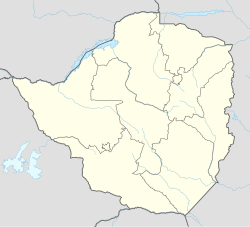Marondera: Difference between revisions
| Line 36: | Line 36: | ||
== History == |
== History == |
||
It was first known as Marandella's Kraal, corrupted from Marondera, chief of the ruling VaRozvi people who lived in the area. British colonialist as they were colonizing Zimbabwe, first used it as a rest stop on the way to Harare. Later destroyed in the Shona resistance of 1896, the town was moved 4 miles (6 km) north to the |
It was first known as Marandella's Kraal, corrupted from Marondera, chief of the ruling VaRozvi people who lived in the area. British colonialist as they were colonizing Zimbabwe, first used it as a rest stop on the way to Harare. Later destroyed in the Shona resistance of 1896, the town was moved 4 miles (6 km) north to the [[Beira–Bulawayo railway]] line. |
||
Constituted a village in 1913, it became a town in 1943. During the South African [[Boer War|(Boer) War]] it was used by the British as a staging point for military operations into the [[South African Republic|Transvaal]], and in [[World War II]] it was a refuge for displaced [[Polish people|Poles]]. |
Constituted a village in 1913, it became a town in 1943. During the South African [[Boer War|(Boer) War]] it was used by the British as a staging point for military operations into the [[South African Republic|Transvaal]], and in [[World War II]] it was a refuge for displaced [[Polish people|Poles]]. |
||
Revision as of 13:02, 12 February 2020
This article needs additional citations for verification. (June 2017) |
Marondera | |
|---|---|
City | |
Mottoes:
| |
| Coordinates: 18°11′23″S 31°32′48″E / 18.18972°S 31.54667°E | |
| Country | |
| Province | Mashonaland East |
| District | Marondera |
| Village | 1913 |
| Town | 1943 |
| City | 1982 |
| Government | |
| Elevation | 1,688 m (5,538 ft) |
| Population (2013) | |
• Total | 68,017 |
| Time zone | UTC+2 (CAT) |
| Climate | Cwb |
| Website | www.maronderardc.org.zw |
Marondera (known as Marandellas until 1982) is a city in Mashonaland East, Zimbabwe, located about 72 km east of Harare.
History
It was first known as Marandella's Kraal, corrupted from Marondera, chief of the ruling VaRozvi people who lived in the area. British colonialist as they were colonizing Zimbabwe, first used it as a rest stop on the way to Harare. Later destroyed in the Shona resistance of 1896, the town was moved 4 miles (6 km) north to the Beira–Bulawayo railway line.
Constituted a village in 1913, it became a town in 1943. During the South African (Boer) War it was used by the British as a staging point for military operations into the Transvaal, and in World War II it was a refuge for displaced Poles.
Demographics
The indigenous population is mostly Shona.
Education
Marondera is home to many schools and colleges:
- Bernard Mizeki College
- Marondera High School
- Peterhouse Boys' School
- Peterhouse Girls' School
- Ruzawi School
- Springvale House
- Waddilove High School
- Watershed College
- Nyameni High School
- Nagle House Girls High School
- Godfrey Huggins Primary School
- Cherutombo High School
- Ruzawi School
- Peterhouse group of schools
Climate
| Climate data for Marondera (1961–1990) | |||||||||||||
|---|---|---|---|---|---|---|---|---|---|---|---|---|---|
| Month | Jan | Feb | Mar | Apr | May | Jun | Jul | Aug | Sep | Oct | Nov | Dec | Year |
| Mean daily maximum °C (°F) | 24.8 (76.6) |
24.2 (75.6) |
24.2 (75.6) |
22.9 (73.2) |
21.5 (70.7) |
19.3 (66.7) |
19.2 (66.6) |
22.0 (71.6) |
25.5 (77.9) |
26.0 (78.8) |
25.8 (78.4) |
24.3 (75.7) |
23.3 (73.9) |
| Mean daily minimum °C (°F) | 14.8 (58.6) |
14.7 (58.5) |
13.8 (56.8) |
11.5 (52.7) |
8.9 (48.0) |
6.1 (43.0) |
5.9 (42.6) |
7.3 (45.1) |
10.5 (50.9) |
12.5 (54.5) |
13.8 (56.8) |
14.5 (58.1) |
11.2 (52.2) |
| Average rainfall mm (inches) | 193.4 (7.61) |
149.1 (5.87) |
90.3 (3.56) |
48.7 (1.92) |
10.1 (0.40) |
5.4 (0.21) |
3.0 (0.12) |
3.0 (0.12) |
6.8 (0.27) |
40.3 (1.59) |
113.1 (4.45) |
187.7 (7.39) |
850.9 (33.50) |
| Average rainy days | 14 | 12 | 9 | 5 | 2 | 1 | 1 | 1 | 1 | 5 | 10 | 15 | 76 |
| Source: World Meteorological Organization[1] | |||||||||||||
References
- ^ "World Weather Information Service – Marondera". World Meteorological Organization. Retrieved 13 May 2016.


